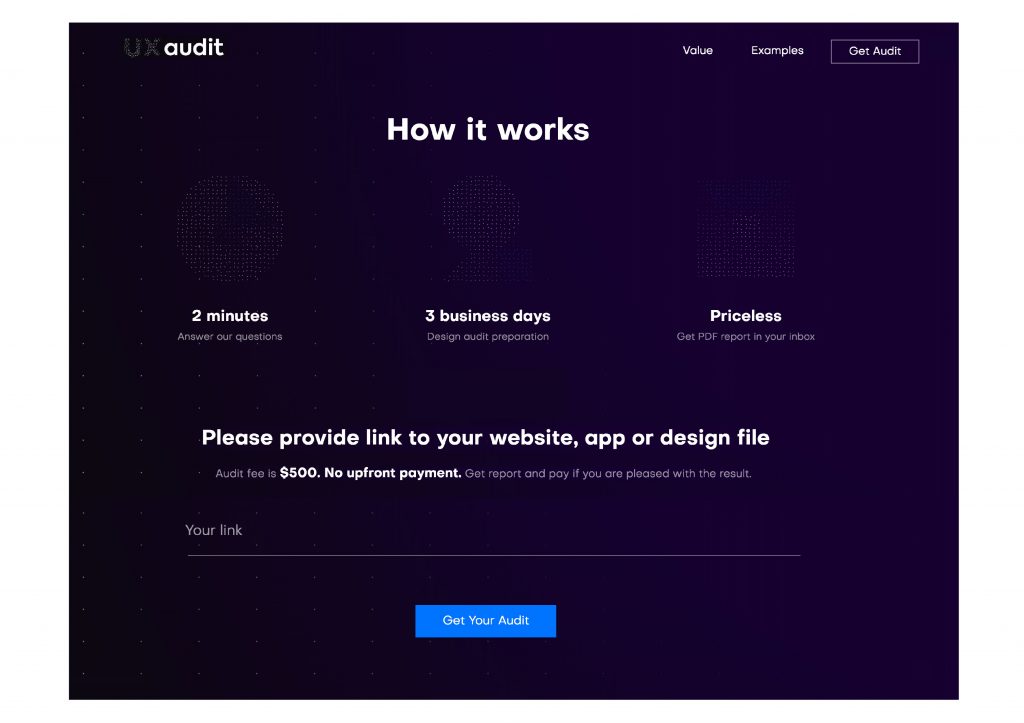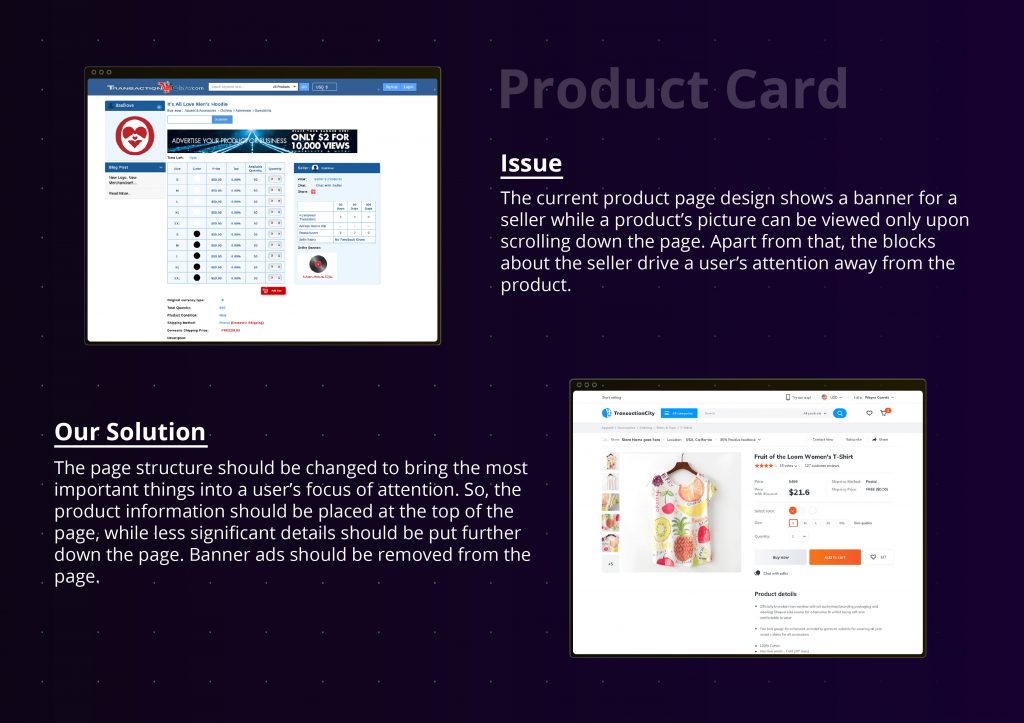What Is User Experience Audit and Why Is It Useful?

Almost every post on this blog refers to user experience (UX), i.e. users’ emotions and attitudes about using websites, applications, and devices, including respective user interfaces (UI). UX design lies at the core of most successful products. For example, during its first year, Amazon invested 100 times more into customer experience than into advertising.
Customers have been regularly asking Alternative-spaces’ designers to audit the UX of their websites and mobile apps. Finally, the department added the service to its list. However, since even specialized agencies seem to be using words like user experience evaluation, usability testing, or usability audit interchangeably, we feel we should explain in greater detail what Alternative-spaces’ designers and other specialists do along the UX lines. If you are not interested in our expertise, you still might like to learn more about UX assessment and its benefits.
User Experience during Product Development and Beyond
User experience encompasses the practical, experiential, and affective aspects of human-computer interactions. UX designers aim to enhance people’s satisfaction with a website, mobile application, or other software. They primarily focus on several high-level constructs defining the UX measures:
- utility
- usability
- aesthetics
- stimulation
- identification
- value
If you wish your website, web application, mobile app, or another product to generate revenue, it’s vital to check all these items even for the minimum viable product.

In user-centric software development, which is Alternative-spaces’ approach as well, UX permeates all stages of product creation, and everybody is involved in the appropriate UX assurance.
Every commercial website is built to have visitors take target actions – sign up, make a purchase, and so on. However, there’s much more to it. Users should want to do it and be able to do it easily. During the ideation and business analysis stage, project managers elicit the businesses’ requirements and study the end-users’ needs equally rigorously. When a specification is written or assessed, UX designers and developers provide usability consulting. Wireframes and prototyping are all about website usability, as is the UI/UX design stage. The right technologies and quality programming help ensure the system’s proper performance, and excellent content should increase the future users’ satisfaction too.
Usability testing should be set up during the development stage and afterward. It helps detect any problems, distractions, or bottlenecks in the website’s work that prevent users from taking the desired actions.
The quality assurance and product acceptance stages may be considered a website’s first user experience audit. For example, a UX-centered QA audit may cover at least the conformity of the site’s:
- text and non-text content
- labeling (e.g., page titles, breadcrumbs, and the labels of the forms, grids, etc.)
- the general, search, and workflow navigation
- controls and links
- forms
- feedback elements
- visual hierarchy
- accessibility
Subsequent UX assessments should be part of the ongoing maintenance. They will show whether the website continues meeting the users’ and business needs in a changing world.
Continuous testing and adjustments will help maintain a high level of overall customer satisfaction.
If the developers built the system thoroughly and have considered all usability trends, the website should perform well for years. The owners may start neglecting regular health checks. The need for conducting a UX audit becomes more urgent when a website underperforms or causes problems for the business. In this case, external assistance should be sought.
It’s usually at this phase of a website’s lifecycle that owners request an audit from Alternative-spaces. An outdated UI design is a less severe case. The owners wish to improve users’ experiences to match the upgraded look. Their request for a professional UX review is also motivated by a desire to test our skills in case they order a redesign with Alternative-spaces.
How User Experience Audits Are Done
Alternative-spaces’ audit process is straightforward and pretty short.

Agencies specializing in UX audits, especially for big corporations, have a longer and more complex procedure in place. It can be roughly divided into UX review and usability testing. The first identifies any misalignments between the business and user objectives. Testing with real users helps explain them. Along with the six primary constructs, the UX teams may review 100+ secondary factors that affect conversions.
Depending on the website type, audit goals, and the client’s and auditor’s requirements and limitations, a UX audit process may include a variety of components and methods:
- Review of business and user objectives
- Personas building
- Technical audit
- A/B testing
- Traffic/engagement
- Form analysis
- Search log analysis
- Links audit
- Click tests
- Navigation testing
- Heat maps analysis
- Scroll maps analysis
- 5-seconds testing
- Website content audit
- Sales data analysis
- Acquisition-behavior-conversion
- Surveys, polls, and interviews
- Wireframing and prototyping
- Analysis of competitors’ sites
- Marketing audit
- Usability audit
… and more. Testing on users is integral to an in-depth UX audit. It implies the use of advanced analytics instruments and tools that anonymously track users clicking, scrolling, looking, and moving within a website. It shows where users got stuck, hesitated, were looking for the information too long, or even left the site. Depending on traffic volume, the tracking of user behavior and website performance may take a few days or a few weeks. For instance, a SaaS product and marketing website will take two weeks to evaluate.
The deliverable is a UX audit report. You can see an example here, but formats vary, often including videos. The document not only cites statistics as to the visitors, sessions, bounce and conversion rates, etc., it also identifies those elements that distract users or hinder conversions and supports the findings with facts. Simultaneously or afterward, prioritized recommendations are given for fixing issues and improving the site’s performance and specifically for search engines, onboarding, increasing sales, etc. The report also offers mockups and resources for such improvements. Experts may organize a presentation or video conference and walk the client through every issue or recommendation.
Such an audit may take the team a month to accomplish and cost around $10,000. A freelancer UX consultant will cost less. For example, a checklist of the major challenges, which takes roughly two days, will cost upwards of $1,000.

If a company wishes to save money, an internal team of designers, developers, product strategists, and business managers might be able to handle this. However, their close familiarity with the site and business may result in blind spots. Along with the skills and technical abilities that may not be in place, the procedure requires a significant investment of time and labor.
Together with the inexperienced UX auditors’ learning curve, it may hamper or at least delay other tasks.
We believe that not every case requires considerable investments of time, effort, and money. Usually, mere compliance with UX standards proves sufficient for solving most issues.
Alternative-spaces’ website design and usability audit is performed by a professional UX designer or a team. They check the website for compliance with UX best practices in the first place. The information provided by the client helps to simulate the visitors’ experience on the site, test the user flows, and identify the points where users are likely to incur difficulties. There’s no observation or experimentation with real users, mostly because the sites are in niches where an experienced designer can see any mistakes and problems right away.
When we need to interview and observe users actually interacting with the website, we recruit a few volunteers. According to the world’s foremost authority in UX, just five users can reveal about 85% of all usability problems on a website.
The stated short timeframe limits the audit scope. However, the evaluation of even five pages may result in eye-opening insights, provide a proof of concept, or convince stakeholders that a further thorough examination is warranted.
The resulting report includes:
- Assessments of:
- Initial impression
- Website structure
- Components prioritization
- User flow
- Fonts
- Colors
- Readability
- Mobile responsiveness
(Parameters 1, 3, 4, and 8 are critical to conversion rates)
- Page-by-page list of identified issues and less-than-perfect areas, including annotated screenshots;
- Heuristics-based recommendations for corrections.

The report may also recommend testing with more users, mobile device testing, or SEO enhancements, or even complete redesign of the website.
A capable UI/UX design team can turn a UX audit results into the website improvements within a few days or 4-6 weeks, depending on the severity of the discovered problems.
When and Why Conduct a UI/UX Audit
The rule of thumb is that a holistic audit is necessary at the beginning of redesigning a site that has been live for some time. New features are usually evaluated with just usability testing.
Other possible reasons for having a usability review or entire UI/UX audit:
- your website is a few years old;
- data indicates that traffic has declined;
- the site was never or not regularly tested by a UX expert;
- your team does not have a professional UX designer;
- your site improvement process doesn’t take user feedback into account;
- startup launching a new product needs an external opinion on whether the MVP is user-friendly;
- a new website does not perform as expected, e.g., user signups are suspiciously low;
- the web pages rank well but conversions are poor or stagnant;
- after three or more months since the website redesign, instead of generating more inquiries or sales, the numbers are flat;
- the company wants the site to grow;
- it’s time to update the information hierarchy or the user flows;
- SEO professionals require an audit to support their marketing strategies.
Forrester’s research once reported that, on average, every dollar invested in UX brings $100 in return. Here are some of the possible benefits resulting from professional UX reviews and audits:
- A review will help you determine the reasons for low retention and conversions, or other issues you’re experiencing. When UX teams test with real users, they prove the hypotheses. Recommendations based on observation and measurement, rather than guesswork and opinions, can help you update the website faster and to a greater effect.
- After you work through and eliminate major issues, website lead flow may increase by 10% and more in the following month. Before a redesign, the awareness of the friction points and cognitive overloads that lead to low conversions helps address them upfront. After a perfectly executed UX audit and research-based improvements/redesign, conversions may reportedly increase by 30-75%.
- It’s also way cheaper and faster to fix problems on an existing site than to build a new one.
- Excellent UX may help you reduce the customer acquisition cost and cut support costs.
- Along with any defects, a full UX review will help you understand your website’s strengths and find opportunities for improvement.
- A well-done UX audit produces metrics that can be used in future website tweaks.
- The results of a smart redesign, such as better user engagement, more accessible information, faster task completion, fewer support calls, and others, will help improve customer loyalty and retention and promote a better perception of your brand.
Through usability audits and other methods, UX experts help in creating an alignment between the business and website visitors. However, it takes a whole team to build, test, maintain, and promote a quality website. Besides each team member’s skills in programming, web UI design, information architecture, functional testing, or content writing, the knowledge of and experience in UX quality assurance is a must.
Contact Alternative-spaces if you are looking for this kind of team. Almost twenty years of successful web and mobile development ensure an excellent understanding of the UX requirements for businesses. Our usability audit service can be the first step in your product’s transformation journey.
Content created by our partner, Onix-systems.
 Home
Home